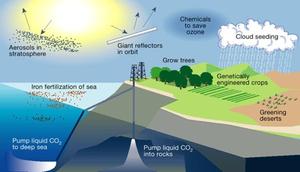Climate conundrumGeoengineering may affect different regions differently
Geoengineering approaches would succeed in restoring the average global temperature to “normal” levels, but some regions would remain too warm, whereas others would “overshoot” and cool too much; in addition, average rainfall would be reduced

Various geo-engineering plans // Source: treehugger.com
Reflecting sunlight from the Earth by geoengineering would undoubtedly cool the climate, but would different countries agree on how much to reflect? Research by climate scientists at the University of Bristol shows that the impact of geoengineering would be felt in very different ways across the world.
Previous studies of geoengineering approaches, aimed at averting dangerous climate change, have shown that although the average global temperature could be restored to “normal” levels, some regions would remain too warm, whereas others would “overshoot” and cool too much. In addition, average rainfall would be reduced.
This new study looked at the impacts of different strengths of geoengineering, from full strength (sufficient to return global average temperatures back to normal), through to no geoengineering.
Reporting in Geophysical Research Letters, the researchers looked at how the impacts caused by these different strengths of geoengineering differed from region to region, using a comprehensive climate model developed by the U.K. Met Office, which replicates all the important aspects of the climate system, including the atmospheric, ocean and land processes, and their interactions.
Their analysis revealed that with increasing geoengineering strength, most regions become drier while others buck the trend and become increasingly wet. For example, the United States became drier with increasing geoengineering, and returned to normal conditions under half-strength geoengineering, whereas Australia became wetter, returning to normal conditions only for full strength geoengineering
Pete Irvine, lead author on the paper, points out there are likely to be disagreements over any future geoengineering schemes: “If there is a large amount of global warming in the future there would be no strength of geoengineering that would be best for everyone: some may be better off without any geoengineering while others may do better with a large amount.”
The team suggest that global average figures are too simple a measure to assess the impacts of geoengineering, and that decision makers of the future need to consider a variety of impacts, such as on regional precipitation, sea-level response, global crop yield before deciding whether embarking on geoengineering would be the right choice.
The work, however, does offer some way forward. Co-author Dan Lunt added: “Our simulations indicate that it might be possible to identify a strength of geoengineering capable of meeting multiple targets, such as maintaining a stable mass balance of the Greenland ice sheet and cooling global climate, but without reducing global precipitation below normal amounts or exposing significant fractions of the Earth to unusual climate conditions.”
